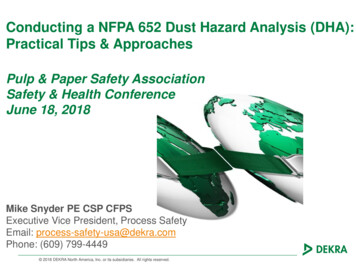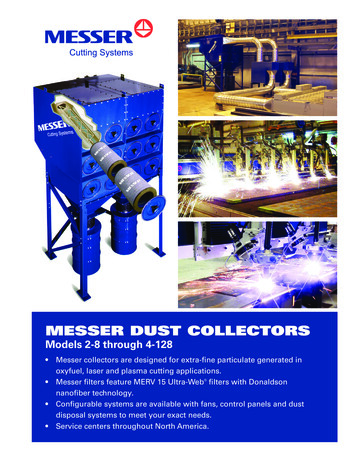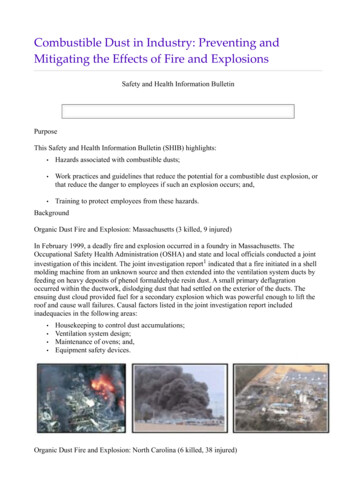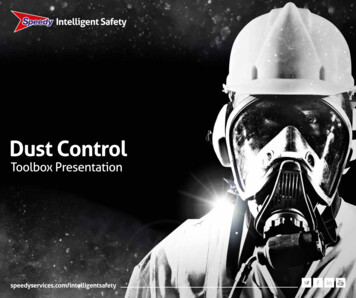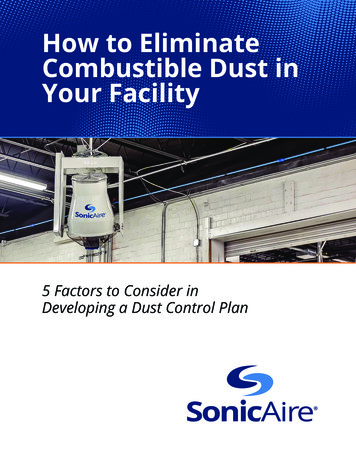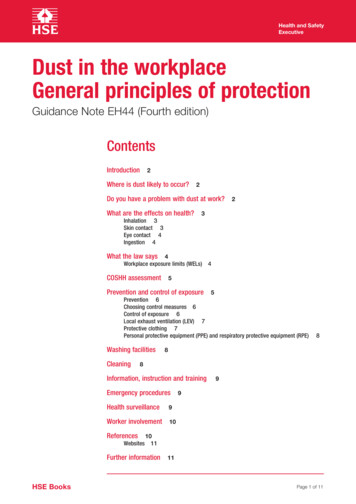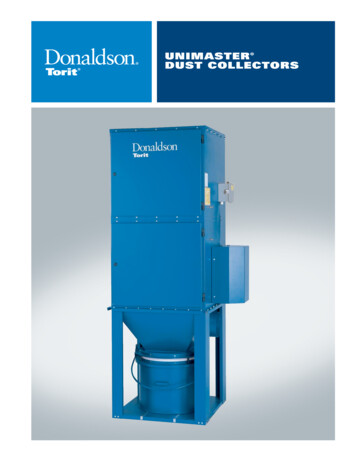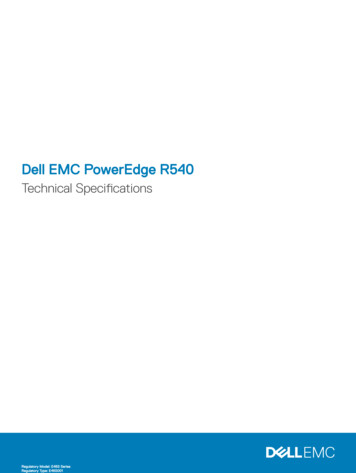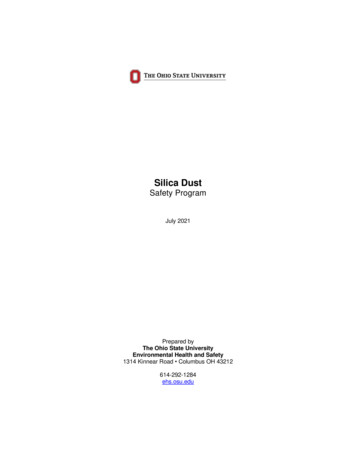
Transcription
Silica DustSafety ProgramJuly 2021Prepared byThe Ohio State UniversityEnvironmental Health and Safety1314 Kinnear Road Columbus OH 43212614-292-1284ehs.osu.edu
Environmental Health and SafetySilica DustSafety ProgramTable of Contents1. Introduction . 32. Responsibilities . 3Environmental Health and Safety . 3Ohio State Departments . 3Supervisors . 4Authorized Person . 43. Definitions . 44. Material Assessment . 55. Exposure Monitoring . 5Initial Exposure Monitoring. 5Periodic Exposure Monitoring . 6Termination of Exposure Monitoring . 6Sampling methods . 6Reporting of exposure monitoring results . 66. Exposure Control. 7Written Exposure Control Plan. 7Pre-project planning . 7Administrative/Engineering Controls . 7Personal Protective Equipment (PPE) . 7Respiratory Protection: Additional Information . 87. Housekeeping and Hygiene Facilities . 88. Medical Surveillance . 99. Training and Recordkeeping . 9Silica Awareness Training. 9Hazard Communication . 10Respiratory Protection . 1010. Signage . 10Appendix A – OSHA Table 1 . 11silica dust program Jul 2021Page 2 of 16
Environmental Health and SafetySilica DustSafety Program1.IntroductionIt is the policy of The Ohio State University (Ohio State) to take precautions to eliminate potential hazardsin the workplace. The purpose of the university’s Silica Dust Safety Program is to identify the hazardsassociated with respirable silica dust and outline the steps to take to ensure employees who work with, oraround silica are not exposed to hazardous levels of silica dust. Additionally, this program is to provideprocedures for common silica related work duties to minimize exposure in accordance with theOccupational Safety and Health Administration (OSHA) standards 29 CFR 1910.1053(l) for generalindustry and maritime, 29 CFR 1926.1153(k) for construction and 29 CFR 1910.1000 Air Contaminants.Crystalline silica is a basic component of soil, sand, granite, and many other minerals. Quartz is the mostcommon form of crystalline silica. All materials containing silica can result in the presence of respirablesilica particles when chipping, cutting, drilling, or grinding takes place. Silica exposure occurs throughinhalation of silica containing particles and may occur through construction and general industry activities.The most severe exposures generally occur during abrasive blasting with sand to remove paint and rustfrom bridges, tanks, concrete structures, and other surfaces. Other activities that may result in silicaexposure include jack hammering, rock/well drilling, concrete mixing, concrete drilling, brick and concretecutting/sawing, tuck pointing and tunneling operations. Exposure to excessive silica dust over longperiods of time can result in adverse health effects such as silicosis.This Silica Dust Safety Program applies to Ohio State employees who are expected to be exposed tosilica dust through the methods outlined above; or through other means, which are determined byEnvironmental Health and Safety (EHS) or their supervisor.2.ResponsibilitiesEnvironmental Health and SafetyEnvironmental Health & Safety (EHS) provides program oversight and consultation to Ohio State workgroups regarding potential risks, exposure prevention and training relating to silica dust exposures.Additional EHS responsibilities include: Conducting building/material assessments for silica containing materials and perform employeesilica hazard assessments/monitoring upon request.Assisting department supervisors with creating an exposure control plan.Reviewing this program annually.Ohio State DepartmentsEach department with responsibilities for maintaining buildings or working in buildings with potentialexposure to silica must: Ensure the applicable components of the Silica Dust Safety Program are available to all affectedemployees.Provide applicable training to employees expected to work in, or with, building materials wherethere is a potential risk for silica exposure.Provide appropriate equipment to comply with the OSHA standard.Coordinate with EHS to schedule exposure monitoring.Enforce work practices and personal protective equipment (PPE) requirements.silica dust program Jul 2021Page 3 of 16
Environmental Health and SafetySilica DustSafety Program Develop housekeeping procedures.SupervisorsOhio State employees who supervise personnel with responsibilities to work in areas where there is a riskof exposure to silica dust, must ensure employees are: Properly trained on the applicable contents of the Silica Dust Safety Program.Provided appropriate engineering controls and equipment.Provided administrative controls when engineering controls are not practical.Provided personal protective equipment (PPE) when engineering controls and administrativecontrols cannot be implemented.Authorized PersonEmployees working in areas where there is an identified risk of silica dust exposure must be properlytrained on all applicable elements of the Ohio State Silica Dust Safety Program. They must be provided,and utilize, the appropriate tools, equipment, and PPE for the task being performed. Additionalresponsibilities include: 3.Participating in exposure monitoring.Using work practices consistent with OSHA Table 1 (see Appendix A).Restricting access to the hazardous work area.DefinitionsThe following definitions are provided to allow for a better understanding of the Silica Dust Safety Program.Action level – A concentration of airborne respirable crystalline silica of 25 μg/m3 , calculated as an 8hour TWA.Authorized person – An employee who has received proper training and exposuremonitoring to safely work with silica containing materials.Crystalline silica – Naturally occurring component in earth soils, sand, graniteand many other minerals resulting in many building materials containing silica.Exposure assessment – The initial determination to find if any employee may beexposed to lead at or above the permissible exposure level. Until the assessment is completed,employees shall take all precautions necessary to maintain exposures below the PEL.High Efficiency Particulate Air (HEPA) – A filtering system capable of trapping and retaining at least99.97% of all particles of 0.3 micron in diameter and larger.Permissible Exposure Limit (PEL) – The OSHA limit for silica dust exposure. It is set at50µg/m3, averaged over an 8-hour workday, as a TWA.Silica containing material – Any material, which has the potential to contain silica at levels,which may pose a hazard to employees when the material is manipulated to create airborne particlessilica dust program Jul 2021Page 4 of 16
Environmental Health and SafetySilica DustSafety ProgramSilicosis – A lung disease caused by inhalation of silica dust. Silica dust can cause fluid buildup and scartissue in the lungs that cuts down the ability for the lungs to fully function. The disease is not curable, butcan be prevented through the use of protective systems.4.Material AssessmentAny time there is a potential for silica containing materials to be involved in a project, sources of silicamust be assessed prior to disturbing. EHS or an authorized contractor can perform building materialassessments to determine silica content in materials.Crystalline silica occurs naturally in the earth’s crust and is a basic component of sand, concrete, brick,asphalt, granite, some blasting grit and wall spackling materials. Employees can be exposed to silicawhen conducting activities such as: Abrasive blastingJack hammeringConcrete crushingHoe rammingRock drillingMixing of concrete or groutConcrete drillingSawing concrete or bricksChipping or scarifying concreteRock crushingMoving or dumping piles of concrete, rock, or sandDemolition of concrete or brickUsing coatings containing silicaRemoving coatings containing silicaIf airborne silica is expected to be generated during the project, EHS shall be contacted to conductexposure monitoring and ensure all safety precautions are followed to minimize exposure to airbornesilica dust.5.Exposure MonitoringInitial Exposure MonitoringOhio State employees that are reasonably expected to come in contact/work with silica containingmaterials where there is a risk of exposure through inhalation of dust should develop an exposuremonitoring program.Initial exposure monitoring should be conducted by OSU EHS to quantitatively evaluate the exposure toairborne silica. Exposure monitoring should be conducted on any employee exposed to airborne silicadust as levels may vary based on job duty within a project. For example, the employee performingconcrete cutting vs an employee providing supervision during the work.If initial monitoring indicates employee exposures are below the action level (25μg/m3), the monitoringmay be discontinued. Where monitoring indicates any level of silica exposure are at or above the actionlevel but below the PEL, periodic exposure monitoring must be repeated within six months of the mostsilica dust program Jul 2021Page 5 of 16
Environmental Health and SafetySilica DustSafety Programrecent monitoring. Where monitoring indicates any level of silica exposure above the PEL, exposuremonitoring must be repeated within three months of the most recent monitoring.Periodic Exposure MonitoringWhenever silica exposure levels are greater than the action level (25 µg/m3), periodic exposuremonitoring is required. It is the responsibility of the affected department to work with EHS and develop aperiodic exposure-monitoring schedule.Action level means a concentration of airborne respirable crystalline silica of 25 μg/m3, calculated as an8-hour TWA. The frequency of exposure monitoring should be as follows:Measured ConcentrationAbove the action level and less than PEL(25 – 50 µg/m3)Above the PEL( 50 µg/m3)Monitoring FrequencyEvery 6 monthsEvery 3 monthsDepartments must work in conjunction with EHS to reassess exposures whenever a change in theprocess, control equipment, personnel, or work practices may reasonably be expected to result in new oradditional exposures at or above the action level, or when there is any reason to believe that new oradditional exposures could be at or above the action level.Termination of Exposure MonitoringPeriodic exposure monitoring may be discontinued if results from two consecutive sampling periods takenat least 7 days apart show that employee exposure is below the action level.Sampling methodsPersonal exposure monitoring will be conducted using an approved NIOSH method. Monitoring recordsshall include the following:The date, number, duration, location and results of each of the samples taken, including a description ofthe sampling procedure used to determine representative employee exposure where applicable. A description of the sampling and analytical methods used.The type of respiratory protective devices, if any.Name and job classification of the employee monitored.Any environmental variables that could affect the measurement of the employee exposure.Reporting of exposure monitoring resultsEHS will notify the department/supervisor of exposure monitoring results as soon as the final laboratoryanalysis is completed. The department/supervisor must provide this information to the affectedemployee(s) within 15 working days.If, during the exposure monitoring, levels are measured which exceed the PEL, the EHS report willinclude steps and controls to reduce exposure to below the PEL.silica dust program Jul 2021Page 6 of 16
Environmental Health and SafetySilica DustSafety ProgramFollow up exposure monitoring may be necessary if engineering or administrative controls are put inplace to reduce hazardous exposures.6.Exposure ControlWritten Exposure Control PlanSupervisors may consult with EHS to develop and implement a written exposure control plan. Theexposure control plan shall include a description of the: Workplace that involves exposure to respirable crystalline silica. Engineering controls, work practices, and respiratory protection used to limit employee exposureto respirable crystalline silica for each task. Housekeeping measures used to limit employee exposure to respirable crystalline silica. Procedures used to restrict access to work areas, when necessary, to minimize the number ofemployees exposed to respirable crystalline silica and their level of exposure.Pre-project planningPrior to projects taking place affecting Ohio State buildings/facilities, EHS reviews planning documents toaccount for potential exposures to hazardous materials, including silica. EHS can conduct buildingmaterial assessments to make determinations if there are any silica containing materials which may beimpacted by the project. Any silica containing materials are addressed and methods for exposure controlare provided by EHS prior to work beginning. If silica containing materials are to be disturbed during theproject, the appropriate exposure control methods will be recommended by EHS.Administrative/Engineering ControlsWhere silica exposures at or above the PEL have been documented, or are expected, the appropriateengineering or administrative controls will be implemented, where feasible. Follow-up exposuremonitoring may be necessary when administrative or engineering exposure controls are utilized. Refer toAppendix A for additional information. Typical controls may involve: Substituting non-silica containing materials for use while abrasive blastingAlternative methods such as pre ordering grout already mixed instead of on- site mixing in bulkLocal exhaust ventilationGeneral ventilationLimit worker access to high exposure areasVacuum methods with HEPA filtersDistanceDust control productsContainmentUse of water to keep dust downGeneral work practices such as good housekeeping, , development of specific SOPs to minimizeexposurePersonal Protective Equipment (PPE)In addition to administrative/engineering controls, employees may be required to wear specific PPEduring the disturbance of silica containing materials and/or when airborne silica is present. The level ofsilica dust program Jul 2021Page 7 of 16
Environmental Health and SafetySilica DustSafety Programprotection will depend on the task being conducted and the tools being utilized to complete the task.Recommended PPE will typically include: Respiratory ProtectionDisposable or reusable work clothingLeather glovesSafety glasses or gogglesFace shieldBoot covers or rubber bootsRespiratory Protection: Additional InformationRespiratory Protection is required under any of the following circumstances: Where exposures exceed the PEL during periods necessary to install or implement feasibleengineering and work practice controls.Where exposures exceed the PEL during tasks, such as certain maintenance and repair tasks,for which engineering and work practice controls are not feasible.During tasks for which an employer has implemented all feasible engineering and work practicecontrols and such controls are not sufficient to reduce exposure to or below the PEL.During periods when the employee is in a regulated area.Employees utilizing a respirator must adhere to the policies outlined in the Ohio State RespiratoryProtection Program.The following table provides recommended respiratory protection levels based on the measured oranticipated exposure levels:RespiratorProtection FactorN95Less than 50 µg/m3Half-face with HEPA filters50 – 500 µg/m3Full-face with HEPA filters500 – 5,000 µg/m3SCBAAbove 5,000 µg/m37.Typical Silica Activity- Used on voluntary basis to control lowexposures- Housekeeping (wet method)- Saw cutting (wet method)- Drilling concrete (wet method)- Power tools with dust collection- Equipment operating with open cab- Chipping concrete- Jack Hammering- Power tools without dust collection- Mixing grout in bulk- Vacuum abrasive blasting- Abrasive blastingHousekeeping and Hygiene FacilitiesIn areas where silica containing dust may be present, all surfaces must be maintained free fromaccumulations of dust to minimize potential silica exposure. Dust and other silica containing debris mustbe removed from the work area as soon as possible.silica dust program Jul 2021Page 8 of 16
Environmental Health and SafetySilica DustSafety ProgramAcceptable method of silica dust removal includes the use of HEPA vacuum or wet methods such as wetmopping. Unacceptable methods of silica dust removal include dry sweeping, dry brushing ,vacuumcleaners, shop vacuums, and compressed air. Employees must follow all recommended procedures andutilize recommended PPE during silica containing debris cleanup activities. Where silica containingmaterials are used, impacted, or being removed; the following requirements must be met: 8.PPE should be removed upon work completion and disposed of after each use.Employees must wash hands and are recommended to shower prior to leaving work.Contaminated PPE, including footwear is not worn outside the work areas.Medical SurveillanceEmployees exposed to silica levels at or above the Permissible Exposure Limit action level (25 µg/m3) for30 days or more per year, or any employee working with silica who develops signs/symptoms ofexcessive exposure, should be enrolled in the Medical Surveillance Program.All medical surveillance will be performed by Ohio State Employee Health Services and results must beprovided the affected employee and their supervisor within 15 days of the assessment. The medicalsurveillance program consists of medical and work history, baseline and annual examination and chest Xray.Employees enrolled in the medical surveillance program should be examined annually to track anychanges as a result to exposure to silica dust.9.Training and RecordkeepingSilica Awareness TrainingSilica awareness training must be offered to affected employees prior to working with silica and annuallythereafter. The training is available in person or can be found on the EHS d-safety-training.Silica awareness training should include the following: Information about the potential health effects and symptoms of exposure to respirable silicaSafety data sheets for silica, quartz, and applicable products containing silicaSpecific tasks in the workplace that could result in exposure to respirable silicaThe purpose and set up of regulated areas to mark the boundaries of work areas containing silicadustThe specific use of engineering controls, work practices, good housekeeping and PPE to controlexposure to silicaUse and care of PPEExpected exposures to silica dustExposure monitoring processMedical surveillance programIdentification of competent personThe supervisor is required to maintain all training, medical surveillance, and exposure monitoring results.silica dust program Jul 2021Page 9 of 16
Environmental Health and SafetySilica DustSafety ProgramHazard CommunicationHazard Communication training is required by all Ohio State employees and should be conducted initiallyupon hiring. This training contains information regarding safety data sheets (SDSs). Safety data sheetscan be referenced for hazardous materials and can alert to users of the material to the presence of silicadust.Respiratory ProtectionRespiratory protection training, medical clearance, and quantitative fit testing is required under theRespiratory Protection Program. Contact EHS for additional information regarding enrollment in theprogram.10. SignageSupervisors must establish regulated areas wherever employee exposure to silica is expected to exceedthe PEL.Regulated areas must be demarcated from the rest of the workplace in a manner to minimize the numberof employees exposed to silica.In regulated areas where exposure to silica dust may exceed the PEL the following type of signage must bein place to warn employee of hazards.Access to regulated areas is permitted only be employees required to perform work in the area; personnelconducting exposure monitoring; or other personnel as approved by supervisors and EHS.silica dust program Jul 2021Page 10 of 16
Environmental Health and SafetySilica DustSafety ProgramAppendix A – OSHA Table 1Specified Exposure Control Methods When Working With Materials Containing Crystalline SilicaEquipment/taskEngineering and work practice controlmethodsRequired respiratory protection andminimum assigned protection factor(APF) 4 hours/shift 4 hours/shiftNoneNone-When used outdoorsNoneAPF 10-When used indoors or in an enclosed areaAPF 10APF 10(iii) Handheld power saws for cuttingfiber-cement board (with blade diameterof 8 inches or less)For tasks performed outdoors only:Use saw equipped with commercially availabledust collection systemOperate and maintain tool in accordance withmanufacturer's instructions to minimize dustemissionsDust collector must provide the air flowrecommended by the tool manufacturer, orgreater, and have a filter with 99% or greaterefficiencyNoneNone(iv) Walk-behind sawsUse saw equipped with integrated water deliverysystem that continuously feeds water to thebladeOperate and maintain tool in accordance withmanufacturer's instructions to minimize dustemissions:-When used outdoorsNoneNone-When used indoors or in an enclosed areaAPF 10APF 10(i) Stationary masonry sawsUse saw equipped with integrated water deliverysystem that continuously feeds water to thebladeOperate and maintain tool in accordance withmanufacturer's instructions to minimize dustemissions(ii) Handheld power saws (any bladediameter)Use saw equipped with integrated water deliverysystem that continuously feeds water to thebladeOperate and maintain tool in accordance withmanufacturer's instructions to minimize dustemissions:(v) Drivable sawssilica dust program Jul 2021For tasks performed outdoors only:Page 11 of 16
Environmental Health and SafetySilica DustSafety ProgramEquipment/taskEngineering and work practice controlmethodsRequired respiratory protection andminimum assigned protection factor(APF) 4 hours/shift 4 hours/shiftUse saw equipped with integrated water deliverysystem that continuously feeds water to thebladeOperate and maintain tool in accordance withmanufacturer's instructions to minimize dustemissionsNoneNone(vi) Rig-mounted core saws or drillsUse tool equipped with integrated water deliverysystem that supplies water to cutting surfaceOperate and maintain tool in accordance withmanufacturer's instructions to minimize dustemissionsNoneNone(vii) Handheld and stand-mounted drills(including impact and rotary hammerdrills)Use drill equipped with commercially availableshroud or cowling with dust collection systemOperate and maintain tool in accordance withmanufacturer's instructions to minimize dustemissionsDust collector must provide the air flowrecommended by the tool manufacturer, orgreater, and have a filter with 99% or greaterefficiency and a filter-cleaning mechanismUse a HEPA-filtered vacuum when cleaningholesNoneNone(viii) Dowel drilling rigs for concreteFor tasks performed outdoors only:APF 10APF 10Use shroud around drill bit with a dust collectionsystem. Dust collector must have a filter with99% or greater efficiency and a filter-cleaningmechanism(ix) Vehicle-mounted drilling rigs for rockand concreteUse dust collection system with close captureNonehood or shroud around drill bit with a low-flowwater spray to wet the dust at the discharge pointfrom the dust collectorNoneOROperate from within an enclosed cab and usewater for dust suppression on drill bit(x) Jackhammers and handheld poweredchipping toolsNoneNoneAPF 10Use tool with water delivery system that suppliesa continuous stream or spray of water at thepoint of impact:-When used outdoorssilica dust program Jul 2021NonePage 12 of 16
Environmental Health and SafetySilica DustSafety ProgramEquipment/taskEngineering and work practice controlmethodsRequired respiratory protection andminimum assigned protection factor(APF) 4 hours/shift 4 hours/shiftAPF 10APF 10-When used outdoorsNoneAPF 10-When used indoors or in an enclosed areaAPF 10APF 10(xi) Handheld grinders for mortar removal Use grinder equipped with commercially(i.e., tuckpointing)available shroud and dust collection systemAPF 10APF 25NoneNone-When used indoors or in an enclosed areaORUse tool equipped with commercially availableshroud and dust collection systemOperate and maintain tool in accordance withmanufacturer's instructions to minimize dustemissionsDust collector must provide the air flowrecommended by the tool manufacturer, orgreater, and have a filter with 99% or greaterefficiency and a filter-cleaning mechanism:Operate and maintain tool in accordance withmanufacturer's instructions to minimize dustemissionsDust collector must provide 25 cubic feet perminute (cfm) or greater of airflow per inch ofwheel diameter and have a filter with 99% orgreater efficiency and a cyclonic pre-separator orfilter-cleaning mechanism(xii) Handheld grinders for uses otherthan mortar removalFor tasks performed outdoors only:Use grinder equipped with integrated waterdelivery system that continuously feeds water tothe grinding surfaceOperate and maintain tool in accordance withmanufacturer's instructions to minimize dustemissionsORUse grinder equipped with commerciallyavailable shroud and dust collection systemOperate and maintain tool in accordance withmanufacturer's instructions to minimize dustsilica dust program Jul 2021Page 13 of 16
Environmental Health and SafetySilica DustSafety ProgramEquipment/taskEngineering and work practice controlmethodsRequired respiratory protection andminimum assigned protection factor(APF) 4 hours/shift 4 hours/shift-When used outdoorsNoneNone-When used indoors or in an enclosed areaNoneAPF 10Use machine equipped with integrated waterdelivery system that continuously feeds water tothe cutting st collector must provide 25 cubic feet perminute (cfm) or greater of airflow per inch ofwheel diameter and have a filter with 99% orgreater efficiency and a cyclonic pre-separator orfilter-cleaning mechanism:(xiii) Walk-behind milling machines andfloor grindersOperate and maintain tool in accordance withmanufacturer's instructions to minimize dustemissionsORUse machine equipped with dust collectionsystem recommended by the manufacturerOperate and maintain tool in accordance withmanufacturer's instructions to minimize dustemissionsDust collector must provide the air flowrecommended by the manufacturer, or greater,and have a filter with 99% or greater efficiencyand a filter-cleaning mechanismWhen used indoors or in an enclosed area, use aHEPA-filtered vacuum to remove loose dust inbetween passes(xiv) Small drivable milling machines(less than half-lane)Use a machine equipped with supplementalwat
Safety Program silica_dust_program Jul 2021 Page 4 of 16 Develop housekeeping procedures. Supervisors Ohio State employees who supervise personnel with responsibilities to work in areaswhere there is a risk of exposure to silica dust, must ensure employees are: Properly trained on the applicable contents of the Silica Dust Safety Program.
